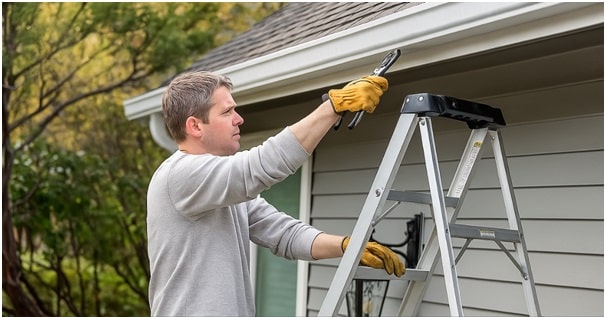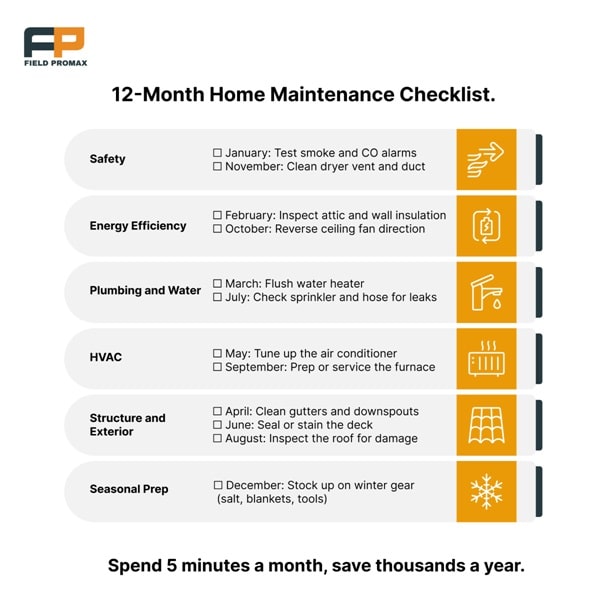More than 60% of U.S. homeowners say they’ve put off repairs they needed because they couldn’t pay for them. The average repair for emergencies is $2,000. This means that even a minor issue could quickly become an enormous financial problem. Many homeowners aren’t ignoring maintenance on purpose. The real problem is that no one hands you a seasonal checklist when you buy a home.
In all honesty, when you’re trying to balance work, family, and even occasional plumbing emergencies, checking your attic isn’t necessarily on your list of priorities.
Repairs are made when things break. However, these “I’ll deal with it later” problems, like slow drips, flashing smoke alarms, or growing ceiling stains, can become emergencies at the worst timing.
This is precisely why this guide is here. Inside, you’ll find:
- Checklists for the seasons that are beneficial
- Maintenance tasks can help you avoid bigger problems.
- Innovative ways to safeguard your home’s value and your budget
Spring: Catch the Damage Before It Grows Legs
The winter was tough. The wind, ice, and freezing temperatures demanded more than just your patience. This is your time to clean up, recover, and find any broken items that slipped by as you fought the frigid winter.
Outside the House
- Examine the roof for missing shingles, sagging spots. or the first signs of rot.
- Clean gutters and downspouts to prevent water damage caused by April’s rains.
- Inspect exterior siding and walls for any cracks, mold, or peeling paint.
- Power wash decks, walkways, and driveways to get rid of the buildup of moss and grime.
- Check outdoor faucets for leaks or creaks that may be caused by frozen pipes.
- Check your irrigation system and search for any clogged or misaligned sprinkler heads
Inside the House
- Check the attic and basement for moisture, mildew, or musty smells
- Replace HVAC filters and schedule a spring tune-up before peak season
- Clean dryer vents and exhaust ducts to prevent fires and improve efficiency
- Open windows and inspect screens, seals, and frames
- Test smoke and carbon monoxide detectors, and batteries should be fresh
If you noticed high heating bills over winter, this is the time to check your insulation. Start with the attic. Heat rises, and if it’s escaping, your money is too.
Spring cleanup isn’t just about curb appeal. It’s your first line of defense against mold, pests, and water damage that tend to sneak in when no one’s looking.
Summer: Keep It Cool, Safe, and Efficient
Summer might feel low-maintenance, but it quietly puts pressure on your home. Your cooling system works harder, outdoor appliances get constant use, and even small plumbing or electrical issues can push your bills higher if ignored.
Indoors
- Service your air conditioner or heat pump before it gives out on a hot day
- Seal ductwork in attics or crawl spaces to keep cool air inside the living space
- Flush the water heater to remove sediment and improve performance
- Inspect appliance hoses for cracks or bulges, especially on washers, dishwashers, and refrigerators
- Test all GFCI outlets to confirm they trip and reset correctly
Outdoors
- Reseal decks, fences, and outdoor wood surfaces to protect against sun and rain
- Trim trees and shrubs that are touching the siding, windows, or roof
- Clean and inspect your grill to avoid grease fires and uneven cooking
- Check exterior lighting for proper function and visibility
- Touch up paint or caulking to protect wood and close up pest entry points
If the upstairs feels like a sauna while the downstairs stays chilly, uneven cooling is often caused by poor insulation or airflow. A quick inspection now saves energy headaches later.
Summer is all about staying ahead of wear and tear, keeping energy bills under control, and making sure your home runs smoothly while you enjoy the longer days.
Fall: Button Things Up Before It Gets Cold
Fall is the home maintenance equivalent of putting on a warm jacket before a snowstorm. You’re not in crisis mode yet, but you’re definitely on the clock. This is the time to prepare for freezing temps, heavy rain, and whatever else winter decides to throw your way.
Exterior Tasks
- Clean gutters and downspouts again to prevent clogs during rain and snow
- Inspect the roof closely for cracked shingles, flashing gaps, or soft spots
- Shut off and drain exterior faucets to avoid burst pipes
- Seal up gaps or cracks around windows, doors, and the foundation
- Check siding and trim for signs of water damage or loose panels
- Touch up paint and caulk where needed to weatherproof your exterior
Interior Tasks
- Plan a furnace inspection and change the air filter
- Ceiling fans should be reversed to force warm air down
- Check carbon monoxide and smoke detectors, and replace the batteries
- Inspect the attic for indications of heat loss or entry
- Examine the weather stripping on windows and doors to prevent drafts
If you have a fireplace, get your chimney inspected and cleaned now. Waiting until winter hits often means long waits and premium prices.
Fall maintenance is less about fixing and more about prepping. A few smart checks now can prevent frozen pipes, heat loss, and surprise breakdowns when it’s below freezing and no one wants to come fix anything.
Winter: Keep It Warm, Safe, and Emergency-Proof
Winter doesn’t just test your furnace. The weather tests every aspect of your home, from insulation to your endurance. You’re spending more time indoors, using more energy, and depending on systems that can’t afford to fail in the middle of a storm.
Indoor Must-Dos
- Test smoke and carbon monoxide detectors every month
- Monitor pipes in cold areas like garages, basements, or crawl spaces
- Insulate exposed pipes to prevent freezing and bursting
- Keep faucets on a slow drip during severe cold spells to relieve pressure
- Vacuum refrigerator coils and check appliance efficiency
- Clean range hood filters to reduce grease buildup and fire risk
Safety and Comfort Checks
- Keep walkways and steps clear of ice to avoid slips and falls
- Inspect bathroom fans and vents to prevent condensation and mold
- Watch for moisture buildup around windows and in corners
- Test backup heating sources or generators if you have them
- Stock up on emergency supplies like batteries, bottled water, and flashlights
Keep an eye on your thermostat settings, especially if you’ll be away for a few days. Dropping the heat too low might save a few bucks, but it risks frozen pipes that cost thousands to fix.
Winter maintenance is all about staying ahead of emergencies. A little prep now helps avoid 2 a.m. furnace failures, burst pipes, or slipping on a front step you forgot to salt.
Year-Round: Monthly and Quarterly Habits That Matter
Not every home maintenance task fits neatly into a season. Some things need a quick check every few weeks, others just a few times a year. Skip them, and you could be dealing with preventable repairs. Stay on top of them and your home will run smoother, longer.
Every Month
- Change HVAC filters or at least inspect them if you use high-efficiency ones
- Check for leaks under sinks, around toilets, and behind appliances
- Clean the garbage disposal with ice cubes and lemon to freshen it up
- Test smoke and carbon monoxide detectors to make sure they still work
Every Quarter
- Run water in unused bathrooms to keep drains from drying out
- Flush toilets in guest rooms or basements to prevent sediment buildup
- Inspect grout and caulk in bathrooms to catch slow leaks early
- Lubricate garage door hinges and tracks to keep them moving quietly
- Scan for pests in attics, basements, and storage spaces
Set digital reminders. A recurring calendar alert can do more than memory ever will. You don’t have to think about maintenance if your phone thinks for you.
Treat these like your home’s regular checkups. They don’t take long, but they save you from big headaches down the road.
Conclusion: Maintenance Isn’t Just Chores, It’s Protection
Being a homeowner means you’re accountable for everything, from noisy doors to squeaky AC units. While it’s tempting to just wait until something breaks and then fix it, it usually ends up costing you more, taking longer to repair, and creating lots of stress. This is why a thorough preventative maintenance program could prolong the life of your assets by 33%.
By adhering to a seasonal and a year-round list, you will be able to:
- Be aware of issues before they escalate into major repairs.
- Increase energy efficiency and overall security.
- Increase the lifespan of systems and appliances.
- Avoid unexpected breakdowns that can make your day miserable,
Even if you’re unable to tick every single box at the right time, checking the majority of them consistently will put you in the lead.
Want an Easier Way to Stay on Track?
You don’t need to remember every filter or fixture. You just need a reliable system that helps you stay organized.
If you’re responsible for more than one home or manage properties professionally, using property management software is one of the most effective ways to cut unnecessary costs. It helps you track maintenance across locations, spot recurring issues early, and avoid the expense of emergency repairs.
If you hire technicians or contractors, it keeps a clear record of what was done, when it happened, and what’s coming up next. Home maintenance doesn’t have to be perfect. It just needs to be steady.
Start with one checklist. Set a few reminders. You’ll be glad you did when winter hits and your home is warm, quiet, and problem-free.



